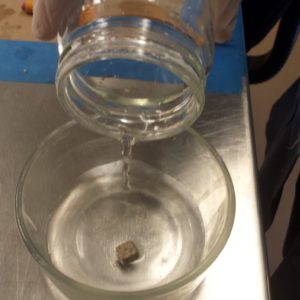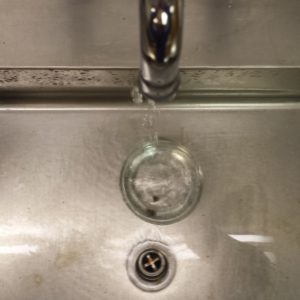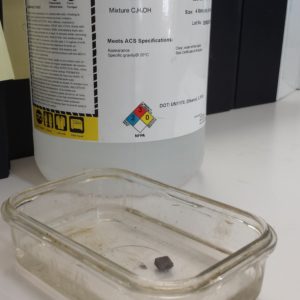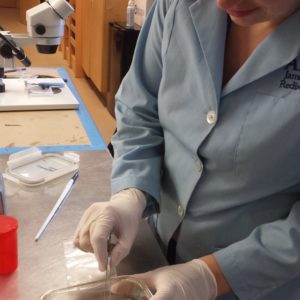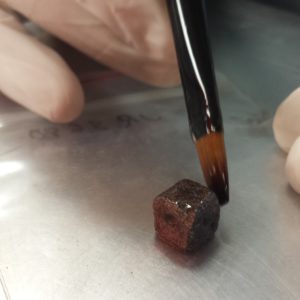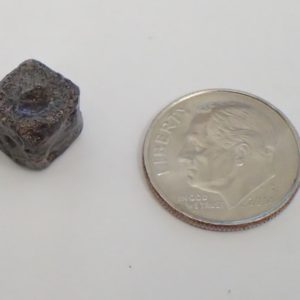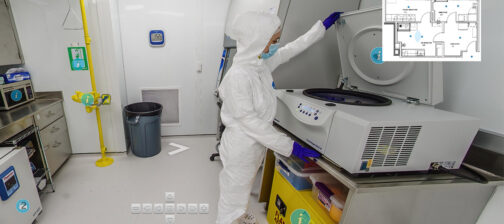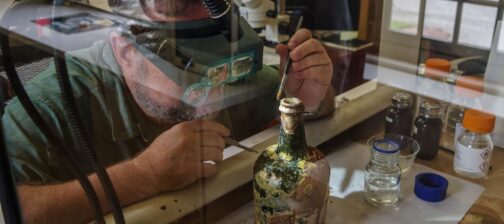This past summer Jamestown Rediscovery archaeologists focused primarily on digging structure 193, the cellar of a building that sat at the corner of a 1608 extension to James Fort. Conservators are now processing the artifacts recovered from the feature, including a lead die found in a posthole cut into the cellar. The posthole soil, however, was likely redeposited cellar fill, so the die would originally have been from this fort-period layer.
Dice were frequently used in games and gambling during colonial times and could be made of wood, bone, ivory, or lead. Jamestown Rediscovery archaeologists have, to date, found approximately 70 dice in and around the fort. Nearly all of these are made of bone and a few of ivory, but this is the fourth lead one to be recovered. The colonists may also have used wooden dice, which would not survive in the acidic tidewater soil.
The soft, malleable nature of lead gave it many functions in the 17th century, including use in children’s toys, pewter tableware, and lids for drinking vessels. Today lead is recognized as a poisonous neurotoxin and conservation is done in such a way as to minimize the production of and exposure to lead dust. Lead corrosion can consist of various oxide and carbonate minerals, some of which can be dissolved in weak acid and others must be mechanically removed.
This die exhibited both oxides and carbonates, so both treatments were used. First conservators mechanically cleaned the die using wooden tools under a microscope to carefully control what was removed from the surface. After mechanical cleaning, the die was soaked in Ethylenediaminetetraacetic acid, also known as EDTA. EDTA forms chemical bonds with certain metal ions in the corrosion, removing them from the surface. However the soaking process must be carefully monitored in order to halt it before the acid begins to etch the metal core. The die was then rinsed thoroughly with water to remove any residual acid. Finally it was soaked in a degreasing solution and coated with Acryloid B72 to protect it from further corrosion.
Lead is unique among the metals as it is very susceptible to VOCs (volatile organic compounds) in the atmosphere. VOCs, which are produced by plastics, wood, paint, and other common materials, catalyze lead corrosion, often resulting in damaging, whisker-like minerals that grow on the surface of the artifact. This die, along with the rest of the collection, is stored in archival material to minimize VOC off-gassing.
related images
- The die right after it came out of the ground.
- Jamestown Rediscovery conservator Katy Corneli is about to begin the conservation process.
- The first step is mechanical cleaning with a brush to remove loose corrosion. The process is done carefully under a microscope to avoid damaging the core metal.
- After mechincal cleaning, the die is soaked in EDTA to remove the remaining corrosion products.
- A close-up of the die as it soaks in EDTA. The bubbles are an indication of the chemical process as it pulls the corrosion away from the lead surface.
- The die is rinsed in tap water to stop the chemical process and remove any EDTA still on the object.
- After rinsing, the die is soaked in a de-greaser.
- The die has to be carefully removed from the de-greasing solution and cannot be touched with bare hands in order to avoid transferring oils back onto the surface.
- The final step is to paint the surface with a protective coating of B72.
- The final result is shown after conservation with a dime for scale.






